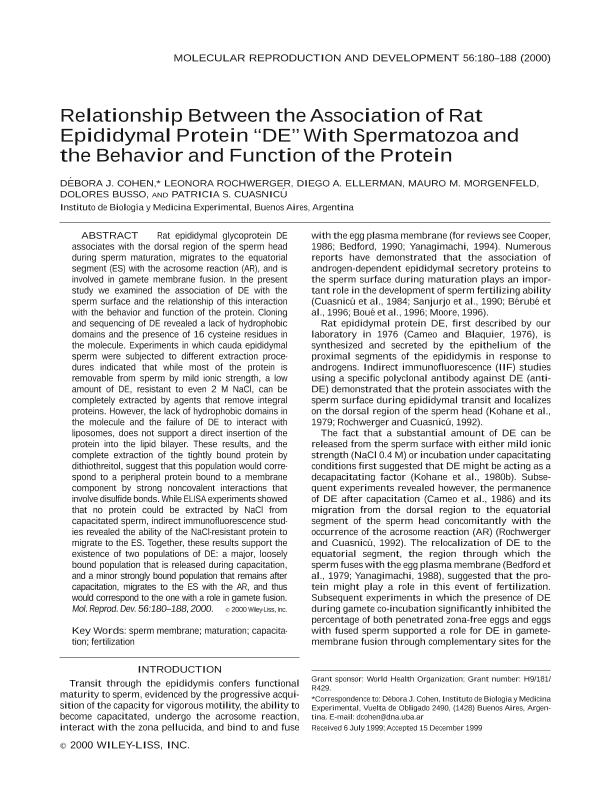Mostrar el registro sencillo del ítem
dc.contributor.author
Cohen, Debora Juana

dc.contributor.author
Rochwerger, Leonora
dc.contributor.author
Ellerman, Diego Andrés

dc.contributor.author
Morgenfeld, Mauro Miguel

dc.contributor.author
Busso, Dolores
dc.contributor.author
Cuasnicu, Patricia Sara

dc.date.available
2017-12-22T05:25:20Z
dc.date.issued
2000-05-12
dc.identifier.citation
Cuasnicu, Patricia Sara; Busso, Dolores; Morgenfeld, Mauro Miguel; Ellerman, Diego Andrés; Rochwerger, Leonora; Cohen, Debora Juana; et al.; Relationship between the association of rat epididymal protein "DE" with spermatozoa and the behavior and function of the protein; Wiley-liss, Div John Wiley & Sons Inc; Molecular Reproduction and Development; 56; 2; 12-5-2000; 180-188
dc.identifier.issn
1040-452X
dc.identifier.uri
http://hdl.handle.net/11336/31338
dc.description.abstract
Rat epididymal glycoprotein DE associates with the dorsal region of the sperm head during sperm maturation, migrates to the equatorial segment (ES) with the acrosome reaction (AR), and is involved in gamete membrane fusion. In the present study we examined the association of DE with the sperm surface and the relationship of this interaction with the behavior and function of the protein. Cloning and sequencing of DE revealed a lack of hydrophobic domains and the presence of 16 cysteine residues in the molecule. Experiments in which cauda epididymal sperm were subjected to different extraction procedures indicated that while most of the protein is removable from sperm by mild ionic strength, a low amount of DE, resistant to even 2 M NaCl, can be completely extracted by agents that remove integral proteins. However, the lack of hydrophobic domains in the molecule and the failure of DE to interact with liposomes, does not support a direct insertion of the protein into the lipid bilayer. These results, and the complete extraction of the tightly bound protein by dithiothreitol, suggest that this population would correspond to a peripheral protein bound to a membrane component by strong noncovalent interactions that involve disulfide bonds. While ELISA experiments showed that no protein could be extracted by NaCl from capacitated sperm, indirect immunofluorescence studies revealed the ability of the NaCl-resistant protein to migrate to the ES. Together, these results support the existence of two populations of DE: a major, loosely bound population that is released during capacitation, and a minor strongly bound population that remains after capacitation, migrates to the ES with the AR, and thus would correspond to the one with a role in gamete fusion
dc.format
application/pdf
dc.language.iso
eng
dc.publisher
Wiley-liss, Div John Wiley & Sons Inc

dc.rights
info:eu-repo/semantics/openAccess
dc.rights.uri
https://creativecommons.org/licenses/by-nc-sa/2.5/ar/
dc.subject
Sperm Membrane
dc.subject
Maturation
dc.subject
Capacitation
dc.subject
Fertilization
dc.subject.classification
Biología Reproductiva

dc.subject.classification
Ciencias Biológicas

dc.subject.classification
CIENCIAS NATURALES Y EXACTAS

dc.title
Relationship between the association of rat epididymal protein "DE" with spermatozoa and the behavior and function of the protein
dc.type
info:eu-repo/semantics/article
dc.type
info:ar-repo/semantics/artículo
dc.type
info:eu-repo/semantics/publishedVersion
dc.date.updated
2017-12-04T17:55:24Z
dc.identifier.eissn
1098-2795
dc.journal.volume
56
dc.journal.number
2
dc.journal.pagination
180-188
dc.journal.pais
Estados Unidos

dc.journal.ciudad
Nueva York
dc.description.fil
Fil: Cohen, Debora Juana. Consejo Nacional de Investigaciones Científicas y Técnicas. Instituto de Biología y Medicina Experimental. Fundación de Instituto de Biología y Medicina Experimental. Instituto de Biología y Medicina Experimental; Argentina
dc.description.fil
Fil: Rochwerger, Leonora. Consejo Nacional de Investigaciones Científicas y Técnicas. Instituto de Biología y Medicina Experimental. Fundación de Instituto de Biología y Medicina Experimental. Instituto de Biología y Medicina Experimental; Argentina
dc.description.fil
Fil: Ellerman, Diego Andrés. Consejo Nacional de Investigaciones Científicas y Técnicas. Instituto de Biología y Medicina Experimental. Fundación de Instituto de Biología y Medicina Experimental. Instituto de Biología y Medicina Experimental; Argentina
dc.description.fil
Fil: Morgenfeld, Mauro Miguel. Consejo Nacional de Investigaciones Científicas y Técnicas. Instituto de Biología y Medicina Experimental. Fundación de Instituto de Biología y Medicina Experimental. Instituto de Biología y Medicina Experimental; Argentina
dc.description.fil
Fil: Busso, Dolores. Consejo Nacional de Investigaciones Científicas y Técnicas. Instituto de Biología y Medicina Experimental. Fundación de Instituto de Biología y Medicina Experimental. Instituto de Biología y Medicina Experimental; Argentina
dc.description.fil
Fil: Cuasnicu, Patricia Sara. Consejo Nacional de Investigaciones Científicas y Técnicas. Instituto de Biología y Medicina Experimental. Fundación de Instituto de Biología y Medicina Experimental. Instituto de Biología y Medicina Experimental; Argentina
dc.journal.title
Molecular Reproduction and Development

dc.relation.alternativeid
info:eu-repo/semantics/altIdentifier/url/http://onlinelibrary.wiley.com/doi/10.1002/(SICI)1098-2795(200006)56:2%3C180::AID-MRD9%3E3.0.CO;2-4/full
dc.relation.alternativeid
info:eu-repo/semantics/altIdentifier/doi/http://dx.doi.org/10.1002/(SICI)1098-2795(200006)56:2<180::AID-MRD9>3.0.CO;2-4
dc.relation.alternativeid
info:eu-repo/semantics/altIdentifier/url/https://www.ncbi.nlm.nih.gov/pubmed/?term=10813850
Archivos asociados
